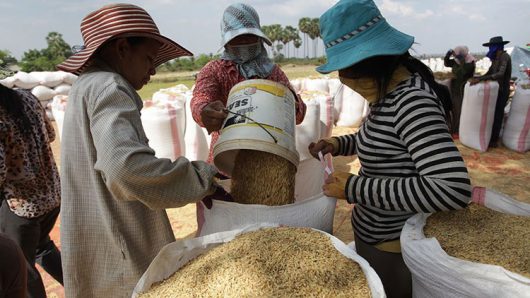
Milled rice exports will recover in 2022 after dropping this year, according to the Cambodia Rice Federation. Cambodia exported 530,000 metric tonnes (mT) of milled rice in the year through November and the federation is forecasting 630,000 mT for the whole of 2021. That compares with a total of 690,000 mT last year, which would be a drop of 8.7 percent. Next year, the federation forecasts a rebound to 700,000 mT which would be a year on year rise of 11.1 percent compared with this year’s estimate.
“The key markets for Cambodia that I can see are the European Union countries. China will still play a big role in high quantity exports,” said Cambodia Rice Federation Vice President Andy Lay.
Lay said the rising shipping costs and shortage of suitable-sized containers that have hit exports over the past two years are likely to continue in the short term.
“That will at least take another six months for everything to get back, not to normal, but to ease the situation,” he said. “The reason for the increasing shipping costs is the closing of the borders and surge in the Covid-19 pandemic in the USA and Europe, making the returning of empty containers quite difficult.
Shipping costs have increased because the shipping companies are taking advantage of this position to increase their profits. The profits of shipping lines in 2021 are almost five times what they did in 2020. Now countries are opening their borders, reducing quarantine so I think economies are recovering. I can see from July onwards the shipping costs may come down,” Lay said.
Lay is the Chief Executive Officer of City Rice Import Export Company Ltd which was Cambodia’s biggest milled rice exporter last year and will hold onto the title this year if his forecast of 100,000 mT is correct. Next year he says the company will export as much as 20 percent more milled rice. The company buys all its rice from local farmers and says it aims for sustainable growth in production.
To meet the expected rise in demand City Rice is considering whether to invest more in its wet paddy drying facilities from 1,500 mT a day capacity this year to as much as 2,000 mT a day in 2022.
Lay said he agreed with the likes of the Asian Development Bank, which has called on Cambodia to modernise its agricultural technology and educate farmers on how to use new equipment but he says it will lead to suffering in the short term.
“In purchasing the technology and as far as the education level as well to accommodate the changes its quite troublesome. I don’t see it in the next couple of years but in the next five to 10 years I can see the new generation of farmers will come up with higher education and so I can see Cambodia will move up to a high-tech agricultural country,” he said.
Cambodia is likely to be increasingly affected by droughts and floods due to climate change and Lay said farmers need to adapt to deal with it.
“Our business is relying on the sky,” Lay said. “Farmers have lost a lot of production, a lot of capital during the drought years but luckily this only happened every three to four years. To farmers flooding is better than drought. Drought has damaged a lot of production yield, has degraded the land. This year we have seen an increase in the growing of the OM5451 variety which is a crop that doesn’t need a lot of water, has high production yields and is less susceptible to climate change.”
Normally Cambodian farmers grow a mix of 60 percent fragrant rice and 40 percent OM5451 but the mix has now shifted to only 25 percent fragrant and 75 percent OM5451 rice, Lay said.
Source: https://www.khmertimeskh.com


